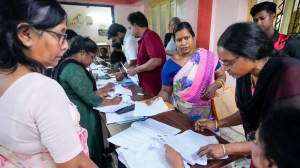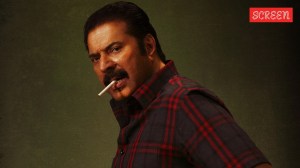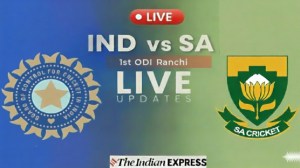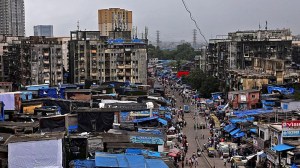Stay updated with the latest - Click here to follow us on Instagram
Notes to the Audience
Satyajit Rays artistry was not restricted to the camera alone,it flowed into prop detailing and an Indian sensibility he brought to book covers. An exhibition celebrates the multifaceted social aesthete.
Actor Kamu Mukherjee as Arjun in Satyajit Rays Joi Baba Felunath has a wickedly funny knife-throwing scene which is one of the more remembered scenes from the filmmakers oeuvre. But what also captivates ones attention is the intricately designed knife throwers board against which Jatayu stands as Arjun throws 10 knives at him. The board,which is only a prop in the five-minute scene has a huge Ravana-like figurine standing with its tongue out,was drawn by Ray himself. As was the set design for General Outrams study for Shatranj Ke Khiladi,and a sketch of Dayamoyee played by Sharmila Tagore in Devi (1960),besides numerous posters for all his films and a host of book jackets and costume designs.
It is known that Ray was a filmmaker par excellence and that cinema was his main passion,but Ray was such an extraordinary man. He did so many things that not many people know of. This exhibition is an effort to tell people about other facets of Ray, says Arup Dey,CEO of the Satyajit Ray Society,which is presenting the prints of these drawings at Siri Fort,Delhi,as a part of the 100 Years of Cinema Festival.
There is a poster for Rays cinematic masterpiece,Pather Panchali. Another for Aparajito,the second in Apu trilogy,apart from Charulata (1964) and Nayak (1966). With fish and sun motifs beside a picture of Apu and his mother in the Pather Panchali poster and straight simple brush strokes creating a womans face for Charulata,Ray displays his training as a graphic artist. The filmmaker had trained in Shantiniketan under Nandalal Bose and BB Mukherjee,who inspired him immensely.
In the exhibition are also character sketches by Ray. There is Mirzas sketch,a simple pencil drawing of Sanjeev Kumar for Shatranj Ke Khiladi (1978) apart from a coloured drawing of detective Felus drawing room from Sonar Kella (1974). Even the painting on the wall (comprising a dancing Radha and Krishna) of the drawing room exudes perfection. Every sketch is so intricate and tells us about the time and energy Ray would put into a project, says Dey,who finds storyboard sketches for an unmade short film on Pt Ravi Shankar most interesting. Rays notes in the margins also open his mind to the audience.
He brought in Indian aesthetics in book cover design by designing jackets for Signet Press. Aam Antir Bhepu,a book by Bibhuti Bhushan Bandopadhyay,has the simplicity of a picturesque village with bold brushstrokes,a shift from the British designs on books. Then there are advertisements for Jabakusum hair oil and Central Tea Board,all full of his wit.
The filmmaker was also a keen photographer and like in all his other projects,he had an eye for detail in this art form as well. In one photo,there are three blind musicians playing music in 1967 London while in another shot in Tehran,three women in burqas are perfectly aligned. Rays art brings alive social realism which eventually seeped into his films too.







